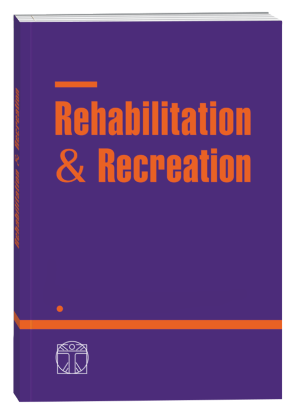POSITIVE INFLUENCE OF EXERCISE AND PHYSICAL ACTIVITY ON THE HUMAN BODY
DOI:
https://doi.org/10.32782/2522-1795.2022.12.16Keywords:
physical activity, physical culture, physical fitness, physical educationAbstract
The most important factors that have a significant impact on health and life expectancy are physical activity. Physical activity is a very important element in human life. As planned, extra effort, it significantly shapes both the personality and health potential. As a result of media support, the physical development of an individual is particularly endorsed in modern society. Recommendations concerning healthy eating, training and the principles of a healthy lifestyle in general, reaching from all over the world, play an important role in building health awareness. The benefits of physical activity are obvious. Systematic physical activity is a very strong biological stimulator and is one of the main determinants of human physical and mental health. In theory, physical activity is dedicated to all people who are capable of doing it. Broadly understood physical activity includes recreational physical activity (including most amateur sports and dance), professional sports, physical activity at home and in the vicinity, and physical activity related to transport / mobility. Factors influencing the degree of physical activity are environmental factors, such as topography and buildings, the existing sports infrastructure, and economic and social factors. An important factor is also the way of getting around, which has also undergone significant changes in recent years, in particular using the car to a greater extent than in the past. In such conditions, the role of physical activity increases in ensuring a high level of health, increasing life expectancy, and maintaining human capacity for work. Thanks to physical activity, productivity and quality of life are ensured. This is a component of the success of every person, regardless of the field of work. Giving up physical activity can lead to diabetes, obesity, heart and circulatory system diseases, as well as changes in the joints and spine.
References
Григус І.М., Хома О.В. (2022). Оздоровчо-рекреаційна рухова активність у профілактиці хронічних неінфекційних захворювань чоловіків похилого віку в умовах карантинних обмежень. Реабілітаційні та фізкультурно-рекреаційні аспекти розвитку людини=Rehabilitation & recreation. Рівне, № 11. С. 163-172.
Bahrynowska-Fic J. (red.) (1999). Właściwości i metodyka ćwiczeń fizycznych oraz sport inwalidzki. Wyd. Lek. PZWL, Warszawa. 6.
Barankiewicz J. (1998). Leksykon wychowania fizycznego i sportu szkolnego. Wydawnictwa Szkolne i Pedagogiczne, Warszawa. 124.
Brown W. (2002). The benefits of physical activity during pregnancy. Journal of Science and Medicine in Sport. 13-26.
Drygas W., Jegier A. (2006). Zalecenia dotyczące aktywności ruchowej w profilaktyce chorób układu krążenia. Kardiologia zapobiegawcza. Naruszewicz M. (red.). PTBNM. 59-74.
Grygus I. (2017). The role of physical activity in the rehabilitation of patients suffering from mild persistent bronchial asthma. Physical Activity Review, 5: 155-166.
Grygus I., Nohas A. (2013). Improvement of Life Quality of the Patients with Rheumatoid Arthritis with Help of Physical Activity. Journal of Health Sciences, 3(1), 97-104.
Grygus I., Chovpylo M., Ortenburger D. (2018). Role of Physical Activity in the Process of Physical Rehabilitation of Pregnancy. Physical Education, Sports and Health Culture in Modern Society, (2(42), 102-110.
http://www.eufic.org/article/pl/5/22/artid/Wytyczne-aktywnosci-fizycznej/
Kasperska K., Smolis-Bąk E., Białoszewski D. (2014). Metodyka nauczania ruchu. Usprawnienia pacjentów na zajęciach grupowych. Oficyna Wydawnicza WUM, Warszawa. 45.
Kosmol A., Morgulec-Adamowicz N., Molik B. (2015). Podstawowe pojęcia w adaptowanej aktywności fizycznej. Adaptowana aktywność fizyczna dla fizjoterapeutów. Kosmol A., Morgulec-Adamowicz N., Molik B. (red.). Wyd. Lek. PZWL, Warszawa. 19.
Kościuk J. (2015). Znaczenie ruchu i aktywności w życiu człowieka. Wydział Nauk o Zdrowiu Uniwersytetu Medycznego w Białymstoku, Białystok. 147-156.
Kumala R., Krzak M. (2013). Retrospektywny obraz nauczyciela wychowania fizycznego a postawa studenta wobec aktywności fizycznej. Rozprawy Naukowe Akademii Wychowania Fizycznego we Wrocławiu. 98-120.
Mahlovanyy A., Grygus I., Kunynets O., Hrynovets V., Ripetska O., Hrynovets I., Buchkovska A., Mahlovana G. (2021). Formation of the mental component of the personality structure using physical activity. Journal of Physical Education and Sport, Vol 21 (Suppl. issue 5), 3053–3059.
Makowiec-Dąbrowska T. (2012). Wpływ aktywności fizycznej w pracy i życiu codziennym na układ krążenia. Forum Medycyny Rodzinnej. 73.
Olejniczak M. Aktywność fizyczna jest zdrowa! Czy wiesz, dlaczego? http://zdrowie.gazeta.pl/
Skiba M., Muszyńska-Graca M., Dąbkowska B. (2017). Ocena różnych form aktywności fizycznej pracowników umysłowych. Medycyna Środowiskowa – Environmental Medicine. 87.
https://pl.wikipedia.org/wiki/Kultura_fizyczna
Wilczewski A., Chaliburda I., Saczuk J. (red.) (2011). Antropomotoryka. Przewodnik do ćwiczeń. Wyd. Lek. PZWL, Warszawa. 45.
Wojtyła A., Biliński P., Bojar I., Wojtyła K. (2011). Aktywność fizyczna młodzieży gimnazjalnej w Polsce. Probl. Hig. Epidemiol. 36-42.
Woynarowska B. (2007). Edukacja zdrowotna. PWN, Warszawa. 87.
Wytyczne UE dotyczące aktywności fizycznej. Strona internetowa http://ec.europa.eu/sport/library/policy_documents/eu-physical--activity-guidelines2008_pl.pdf
Figiel M. (2016). Wpływ aktywności fizycznej na organizm człowieka. 2.
https://fizjoterapeuty.pl/fizjologia/wplyw-cwiczen-fizycznych-na-organizm.html
Zatoń K., Zatoń K. (2014). Aktywność fizyczna a zdrowie. Rozprawy naukowe Akademii Wychowania Fizycznego we Wrocławiu. 25.
Downloads
Published
How to Cite
Issue
Section
License

This work is licensed under a Creative Commons Attribution-NonCommercial-NoDerivatives 4.0 International License.












